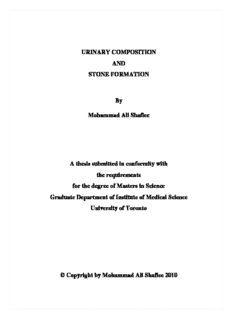
URINARY COMPOSITION AND STONE FORMATION By Mohammad Ali Shafiee A thesis ... PDF
Preview URINARY COMPOSITION AND STONE FORMATION By Mohammad Ali Shafiee A thesis ...
URINARY COMPOSITION AND STONE FORMATION By Mohammad Ali Shafiee A thesis submitted in conformity with the requirements for the degree of Masters in Science Graduate Department of Institute of Medical Science University of Toronto © Copyright by Mohammad Ali Shafiee 2010 Urinary Composition and stone formation Master’s degree 2010, by Mohammad Ali Shafiee, University of Toronto ABSTRACT Background: Kidney stone disease is a common and often debilitating disorder, yet its pathophysiology is poorly understood. This dissertation studies predisposition to kidney stone formation from diurnal variation in physiochemical and physiologic properties of urine and in response to increased fluid intake. Methods: Urine volume, flow rate and constituents were measured in multiple timed specimens from healthy volunteers in a day. Further, subjects were asked to provide specimen over a period of increased fluid intake. Results: A 24-hour specimen missed significant periods of supersaturation in individual urine samples throughout the day. Despite a significant reduction in nocturnal urine flow rate, calcium concentration as well as urine pH and divalent phosphate remained unchanged. Finally, increased water intake did not dilute urine evenly. Conclusion: Mixing multiple urine samples obscures information about periods of increased calcium phosphate precipitation risk over 24 hours. Further, increased fluid intake does not uniformly provide risk protection. ii ACKNOWLEDGMENTS & CONTRIBUTIONS Dedicated to: The Greatest Teacher of All Thanks for all the help and support of Professor Mitchell Halperin Dr. Halperin’s lab technician: Surinder Cheema-Dhadli, Chee Chong & Stella Tang Professor James Scholey Dr. George Tomlinson for statistical analysis iii Table of Contents Title Page (cid:190) LIST OF ABBREVIATION:………..……...…..…...…….... .. ...….…....…...…...........…x (cid:190) DEFINITIONS AND DESCRIPTIONS:………..……...…..…...…….…….. .............…xiv (cid:190) INTRODUCTION:…………………..……………...…….....…………………...….….….1 (cid:190) GENERAL STUDY OBJECTIVES:… …….………….…..…...……........….............…..2 (cid:190) SPECIFIC STUDY OBJECTIVES: ………….…….…..…...…….......….…................…3 (cid:190) GENERAL BACKGROUND: …………..….…………….…..…………..…................…4 (cid:190) PREVALENCE: ……..………………..….…..……….…..…................…4 (cid:190) INCIDENCE: ……..……………………..….…..…….….…..…................6 (cid:190) CLINICAL SIGNIFICANCE: ……..……………………..…...…..…..…6 - Pain………………....………..…..…..…..…..…........…..…….........…6 - Parenchymal kidney injury..….....…..……...….....…..……......... .…6 - Financial significance………..…..…..…..….….......….……...........…7 (cid:190) RECURRENCE RATE: ………..…………..….…...….…..……...........…8 (cid:190) GEOGRAPHICAL DISTRIBUTION: ………..….….........……..........…8 (cid:190) RISK FACTORS: ……….………..….…........…......…...….….….........…9 - Family history….………….…..….…….…….….....…...…...….....…9 - Systemic disorders…….….….…..….…......…...….………....…........9 iv - Environmental factors……….…..….…….......................…..………10 - Dietary factors……..………..…..…....….……..….............………....10 - Urinary factors……..…….…..….……...……...….............….….......11 - Microorganisms…………….…..….……………..….….....................11 (cid:190) KIDNEY STONE MORPHOLOGY:.................................................................................14 - Brushite………………………………….............….….......................15 - Hydroxy apatite:.....................…..…….…............…..….…...…........16 WHY THIS STUDY FOCUSES ON CaPO PRECIPITATES:...........................................17 4 (cid:190) SHORT URINE COLLECTION STUDY (Objective 1): ...............................................20 - Background:.....................….........…...….........……..….…...…........20 - Rationale: ............................................................................................21 - Hypothesis: .........................................................................................22 - Material & Methods: .........................................................................23 - Measurements: ...................................................................................23 - Analytic techniques: ..........................................................................24 - Statistical analysis: ............................................................................24 - Result:................... ..............................................................................25 - Diurnal creatinine excretion to confirm collections accuracy: ..... 26 - Examples of significance of short collections: .................................27 - Statistical analysis: .............................................................................36 - Secondary results: ..............................................................................38 - General discussion: ............................................................................45 - Secondary discussion: ........................................................................46 v - Diurnal variations in the urine flow rate and osmolarity:...............46 - Diurnal variations in urinary excretion of electrolytes and urea:...47 - Diurnal variations in urinary excretion of calcium:.........................47 - Diurnal variations in urinary excretion of phosphate:.....................48 - Diurnal variations in urinary excretion of citrate:...........................50 - Diurnal variations in urinary excretion of magnesium:..................50 - Diurnal variations of urine pH: .........................................................51 (cid:190) OVERNIGHT PRECIPITATION RISK STUDY (Objective 2):……............................53 - Background:........................................................................................53 - Rationale:.............................................................................................55 - Hypothesis: ............. ...........................................................................55 - Material and methods: ......................................................................55 - Measurements: ................ ..................................................................56 - Analytic techniques: ..........................................................................56 - Statistical analysis: ................... .........................................................56 - Result: .............................. ...................................................................57 - General discussion: ............................................................................64 - Physiologic circadian variation of blood pressure: .........................65 - Lower urine pH overnight: ...............................................................65 - Conclusion: .........................................................................................67 (cid:190) INCREASED FLUID INTAKE STUDY (Objective 3):……………..............…….........68 - Background: .......................................................................................68 - Rationale: ............................................................................................69 vi - Hypothesis: .........................................................................................69 - Material and methods: ......................................................................69 - Subjects: .............................................................................................70 - Procedures: ........................................................................................70 - Measurements: ..................................................................................70 - Analytic techniques: ..........................................................................70 - Statistical analysis: ............................................................................71 - Result: .................................................................................................72 - General discussion: .............................................................. .............81 - Events prior to absorption of water:…...…...…......… ...........82 - Degree of cell swelling in the central osmostat:........ .….........83 - Nonosmotic stimuli for the release of ADH:............... ........…83 - Ability to shift water rapidly into muscle cell:............ .…. …83 - Explanation of the sequence of the events after water load:..83 - Conclusion:....…................….............…...... ....…................….........87 (cid:190) ADITIONAL LITERATURE REVIEW:……….………..…….……....….…..…......…88 (cid:190) URINARY COMPOSITION:………………………….………….….….….....…88 - Background: ...…….…… ….……..….……...……….…….............88 - Urine flow rate:…...…….…….….….……..…….……....................89 (cid:190) SOLUTES INFLUENCING URINARY SUPERSATURATION:.……............91 - Measurements of urinary supersaturation:…......……............…..93 - The effect of ionic strength on ionic interaction:.…..…..…….......93 - Ksp of hydroxyapatite and fluorapatite: ……..…..…..…..…...…..96 vii - Supersaturation of solutes: ……………..…..…..…..……………....97 - Activity product ratio and formation product:...…..…..…..….....100 - Observations of urinary supersaturation:.....…..…..…..…...........101 - Urine supersaturation profile:..............…..…..…..….....................102 - Role of urine electrolytes:…..…………...….…..….…..…...….......102 - Role of urine urea:…………….………....…..…..…..….…..…......105 - Role of urine calcium in supersaturation:.….…..…..…..…..…....106 - Role of urine phosphate in supersaturation:......…..…..…....…....113 - Urine pH:……………..…..…..…..………….....……..…..….….…115 (cid:190) STONE FORMATION INHIBITORS AND CHELATING AGENTS:….......121 - Citrate:…..…..………..…..………….....……..…..….…..…..….…121 - Tamm-Horsfall protein:......…………………….……….…….......125 - Osteopontin:…………………………………………….….…..…..126 - Glycosaminoglycans:…………….............................……..…........ 127 - Diurnal variation in urine excretion:…..........................................127 - Other Factors:……………..……............................…………...…..128 - Calcium Phosphate precipitation:…..………........................….…131 (cid:190) STONE FORMATION: ........................................................................................132 - Nucleation: .......................................................................................133 - Homogeneous versus heterogeneous nucleation:………..........….134 - Crystal growth: …….………..………………..………...................135 - Factors influencing crystal growth:…..………..………...…….....135 - Calcium phosphate precipitates chemistry:….....………….….....136 viii - Randall’s plaque formation:….....………………….…………......136 - Characteristics of interstitial plaque (Randall’s plaque):…….....137 - Relationship of plaque to the urothelium:………………….….....140 - Nature of the plaque crystal:……………………………….…......140 - Nature of plaque matrix:…………………………………...…......142 - Calcium oxalate growth over Randall’s plaques:………...…......142 (cid:190) SUGGESTIONS FOR FUTURE STUDIES:……………….…….. ……………….....143 (cid:190) REFERENCES:……....………….…… ………………………………..……..……......144 ix List of Abbreviation Abbreviation _______Explanation _ ACE Angiotensin Converting Enzyme ADH Antidiuretic Hormone (also: vasopressin) APR Activity Product Ratio AQP Aquaporin ARA Activity Product Ratio ARB Angiotensin Receptor Blocker AVP Arginine Vasopressin (also: vasopressin) BMI Body Mass Index CAHV Cell Associated Herpes Virus Ca2+ Calcium CaHPO4 Calcium Phosphate Monohydrogen CaOx Calcium Oxalate CaOxSS Calcium Oxalate Super Saturation CaPh Calcium Phosphate CaPh SF Calcium Phosphate Stone Formation CaPhosSS Calcium Phosphate Supersaturation CaSR Calcium Sensing Receptor CNP Calcifying Nanoparticles DCT Distal Convoluted Tubule x
Description: